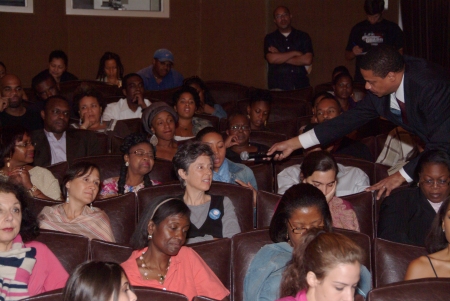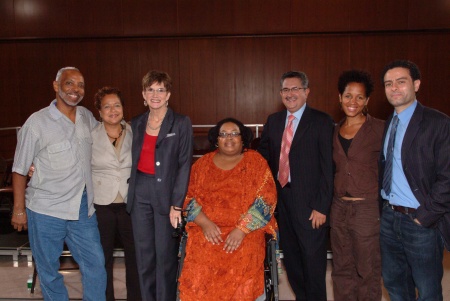A few days ago I had a conversation with a philanthropist. Up until then, I had been very proud of what I accomplished in the last five months. Given the facts—first, that we’ve had minimal financial resources, and second, that no one wants to talk about race relations, especially in healthcare—we have made and are still making great strides forward with our project.
However, all my hard work seemed to unravel in the span of that twenty-minute conversation. My curriculum wasn’t good enough by this man’s standards. He argued that I had not created a way to quantify the benefits the curriculum delivered. I told him I had come to understand that conversations about racism, especially about racism in healthcare, cannot be measured by analytical and intellectual tools. Racism defies analysis. He pointed out several further objections, questions he thought the curriculum didn’t answer. These were hard for me to understand, because I have been consulting with experts in curriculum development and workshop facilitation, and those folks have been telling me the lesson plans are cutting-edge and quite effective. But listening to this gentleman’s response, I began to doubt my own progress.
When I told this person how very proud I was that our website was getting 3,000 hits a month, he went on to talk about an organization he had been working with, that, after some controversy put them in the public eye, began to see 22,000 hits a day. If you compare 22,000 hits every day to 3,000 in a month, it makes you feel awfully small. He mentioned that he was reevaluating where he put his time and energy, and that this other organization was affecting people nationally. Well, when I researched that organization, I found they were not just affecting people nationally—they were reaching people around the whole world. The scope of their work made me feel so small, like a 110-lb person trying to win a fight against an 800-lb, muscle-bound giant.
I wondered why I had felt sad over the past few days, and I realized that comparative thought is designed to reduce you, to make you feel less than. Our whole educational system is based on comparative thought: if you get an A and I get a B, then you must be better than me. Our whole economy is based on comparative thought: we don’t feel content with being ourselves, we want to be like other people instead, and so we buy products that we think will make us happier with our own lives.
Comparative thought relies on man-made markers, or benchmarks, that allow people to measure you and your work. But does that mean the work I’m doing is any less substantial or needed, or that it has any less impact? Just because my website doesn’t get 22,000 hits a day, does that mean it is less informative, less educational, or less valuable?
I write this for those of you who work really hard in small nonprofits and for those of you who work really hard to improve yourselves. Comparison, whether self-inflicted or from another person, is one of the most deadly traps we can fall into. For comparison causes us to doubt the voice of the inner self, the intuitive self, that directs us. It allows outside criticism to challenge the validity of that inner voice.
I will not be defined by someone else’s comparisons. The Deadliest Disease in America stands on its own merits: it is a unique tool for arousing emotion and thought, for assisting anyone open to change to look at racism in a new way. It helps viewers to recognize racism in their own thoughts and to understand how racism manifests itself in unexpected places—even in a profession that proclaims its commitment to healing.
The conversation I had with that philanthropist really hurt me, I have come to understand. It happened only a few days after Obama’s victory speech at Grant Park, where everyone in the audience said, “Yes We Can,” but my conversation was quite the opposite because it was about all the things I couldn’t do or hadn’t done.
The fact is, it’s the average people—the little people—who said they believed in change, who worked hard to get out the vote, who elected Barack Obama. A lot of little fish and some big ones going in the same direction helped changed the current in Washington. In the same way, the hard work of healing the racism in this country will happen when a lot of little fish start working together. The big fish have their part too, but the work of the little fish is equally important.
My film The Deadliest Disease in America—I don’t compare it to other films. How I measure its success is when a person in the audience stands up and says, “I’ve had several complaints from patients over the years about a receptionist in my office. It wasn’t until I saw this film and did the workshops that I realized that all of the patients who complained were Black, and that the receptionist was white. Before seeing the film, I had said, ‘We don’t have those kinds of problems in our office.’ After seeing the film and sitting in the workshop, ‘How to Report Racism in Healthcare,’ I realized that I was part of the problem.”
The situation that prompted me to write this blog made me stronger. I understand now that the gentleman I was speaking to has never seen an audience’s reaction to the film, has not experienced the impact of the workshops, and was playing devil’s advocate. I don’t think his comments were meant to hurt—but they did.
This weekend I head to Washington, DC, to find Donna Brazile. If you know her, tell her I’m coming! Stay tuned for the next phase of the journey!
Namaskar,
Crystal
PS – We’ve posted a 6-minute clip of our film on our website. Check it out at:
http://urutherighttobe.org/disease/videoplaylist/trailer.html

